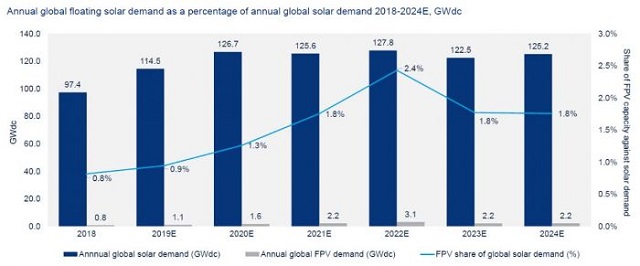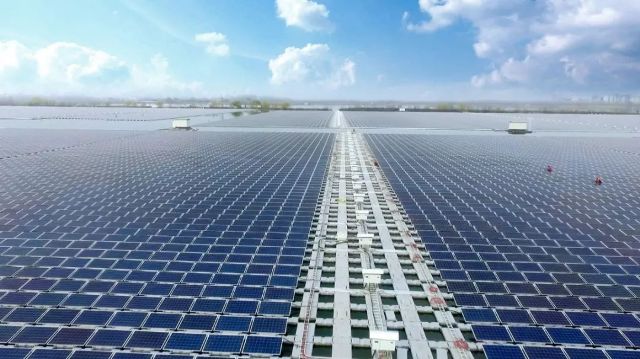Photovoltaic Building Materials Industry "Carbon Peak, Carbon Neutral" Technology Seminar
The global demand for floating photovoltaic power stations will grow at an average annual rate of 22 % from 2019 to 2024, according to a report by Wood Mackenzie Power and Renewable Energy Consultancy. In 2018, there were FPV plants in 27 countries. The country's number will grow to 35 countries by the end of 2019.

Compared with the traditional photovoltaic power station, the floating photovoltaic system is installed on the surface of the floating body. Besides it does not occupy land resources, the ventilation and heat dissipation conditions above the water surface are good, and the cooling of the photovoltaic core equipment by the water body can effectively improve the power generation efficiency.
Huawei intelligent photovoltaic was adopted in the 60MW floating photovoltaic power station in Huaibei.
With the increasing application of floating power stations, the safety problem has attracted increasing attention in the industry.
The floating photovoltaic system works in DC high voltage. The water has conductivity. Once there is leakage, how to protect personal safety? As the humidity of the floating power station is high, the PID attenuation of the component is more serious. How to solve the electric shock risk of the traditional PID suppression method?
The safety design of floating power stations has become the primary factor for owners and design institutes to consider.
Minimizing DC nodes and cables is safer.
As the centralized inverter scheme needs a combiner box, there are many HVDC nodes and high security risks. At the same time, the centralized scheme has more than 100 groups of positive and negative strings in parallel together. When there is leakage due to bad insulation and at the same time, the DC high voltage is in the water, the water biological electric shock will be inevitable.
In addition, if the DC cable skin is broken and falls into the water, it will cause the risk of electric shock in the water scene.
Huawei Group Series Inverter scheme minimizes DC side nodes and cables, which is relatively safe. Huawei's intelligent cluster series inverter connects to one MPPT in every two clusters, and only the current loop can be formed in these two clusters, which has a small probability of leakage, reduces the risk of electric shock, and provides a safety lock for the floating power station.

Huawei patented PID suppression and low loss. The power generation can be increased by 2%.
In a floating power station, the battery components are always working in a high temperature and humidity environment, so PID attenuation is relatively easy to occur. It was tested in a 6MW power station in Dongtai, and the attenuation of the module was about 2.5% after half a year of operation. In a 9.8MW power station in Changshu, the power of some components attenuated by 10% after 2 years of operation.
The inverter DC side negative ground was adopted by the traditional centralized inverter to suppress PID because the centralized inverter has no RCD protection. Touching PV+ will lead to electric shock accident, resulting in personal injury. If PV+ or inter-group cable has grounding faults, it will generate fault current through the ground wire or it will be easy to produce arc discharge, and it is easy to cause fire.
As for Huawei Intelligent Photovoltaic, the anti-PID module was put in the communication cabinet, and automatically the output voltage was adjusted according to the inverter voltage. By injecting voltage between AC virtual N and PE, the PV panel reaches the equivalent of PV to ground, eliminating the negative voltage of PV to ground, and playing the role of inhibiting PID.
More importantly, Huawei's latest PID suppression technology adopts Huawei's patent to construct the virtual neutral point through the inverter circuit. Compared with the traditional scheme of using resistor or inductance to construct the neutral point, it has the advantages of low compensation loss and safer compensation process.
Compared with the traditional PID repair scheme, the power generation can be increased by more than 2%, while supporting a larger subarray of more than 5MW.
At the same time, there is the built-in high-precision RCD (residual current detection) in the Huawei group series inverter which can protect circuit. Even if people accidentally touch PV+, it can also effectively limit the contact current. At the same time, RCD can protect the circuit to cut off the leakage circuit to ensure human safety.
Based on more than 30 years' experience in the design and operation of communication products and power electronics, Huawei Intelligent Group Series Inverter adopts a fusion-free design, which avoids the security risks caused by fuses from the source and reduces the operation and maintenance costs. At the same time, the fully sealed design and the protection level IP65 are all its advantages. The latest 175/185KTL series of products reach IP66 level. The availability reached more than 99.996%, which perfectly matches with the scene of floating photovoltaic power station. The inverters have been in large-scale applications in China, Thailand, Vietnam, Malaysia, Singapore and other places. TUV certifited that the failure rate of Huawei inverters was less than 0.5%, which was absolutely the leading level in the industry.
The era of fair price has arrived, and Huawei has never stopped innovating on the road to improving the safety of photovoltaic power stations. Huawei long-term stable operation has won the hearts of users in this more and more complex power station installation environment. As of H1, 2019, the global cumulative application of Huawei's smart photovoltaic has exceeded 102GW, and its shipment volume has ranked first in the world for four consecutive years from 2015 to 2018. In the new era, Huawei is committed to bringing the digital world into every photovoltaic power station to help customers win the fair price era steadily.
